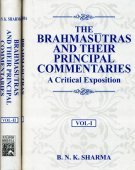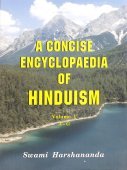Jayatirtha, Jayatīrtha, Jayātīrtha, Jaya-tirtha: 7 definitions
Introduction:
Jayatirtha means something in Buddhism, Pali, Hinduism, Sanskrit. If you want to know the exact meaning, history, etymology or English translation of this term then check out the descriptions on this page. Add your comment or reference to a book if you want to contribute to this summary article.
In Hinduism
Purana and Itihasa (epic history)
Source: Cologne Digital Sanskrit Dictionaries: The Purana IndexJayātīrtha (जयातीर्थ).—A lake in the Kuru country; sacred to Pitṛs.*
- * Matsya-purāṇa 22. 49; 121. 70.

The Purana (पुराण, purāṇas) refers to Sanskrit literature preserving ancient India’s vast cultural history, including historical legends, religious ceremonies, various arts and sciences. The eighteen mahapuranas total over 400,000 shlokas (metrical couplets) and date to at least several centuries BCE.
General definition (in Hinduism)
Source: Hindupedia: HinduismJayatīrtha (A. D. 1340-1388) is a chief proponent of Dvaita Vedānta which was a philosophical stance founded by Madhva (A. D. 1238-1317).
His works on the Dvaita Vedānta philosophy are:
- Nyāyasudhā, a commentary on the Anuvyākhyāna of Madhva;
- Tattvaprakāśikā, a commentary on the Brahmasutrabhāsya of Madhva;
- Nyāyadipikā, a commentary on the Gitātātparyanirnaya of Madhva;
- Prameyadipikā, a commentary on the Gitābhāsya of Madhva;
Jayatīrtha was a contemporary of Vidyāraṇya. He passed away on the bank of the river Kāgiṇī, in Malakheḍa (or Mānyakheṭa). A cave where he used to compose his works is located near the Yaragola village of Yādgiri taluka.
In Buddhism
Tibetan Buddhism (Vajrayana or tantric Buddhism)
Source: OSU Press: Cakrasamvara SamadhiJayatīrtha (जयतीर्थ) refers to one of the “eleven holy bathing places” (Puṇyatīrtha), according to the Guru Mandala Worship (maṇḍalārcana) ritual often performed in combination with the Cakrasaṃvara Samādhi, which refers to the primary pūjā and sādhanā practice of Newah Mahāyāna-Vajrayāna Buddhists in Nepal.

Tibetan Buddhism includes schools such as Nyingma, Kadampa, Kagyu and Gelug. Their primary canon of literature is divided in two broad categories: The Kangyur, which consists of Buddha’s words, and the Tengyur, which includes commentaries from various sources. Esotericism and tantra techniques (vajrayāna) are collected indepently.
Languages of India and abroad
Sanskrit dictionary
Source: Cologne Digital Sanskrit Dictionaries: Aufrecht Catalogus Catalogorum1) Jayatīrtha (जयतीर्थ) as mentioned in Aufrecht’s Catalogus Catalogorum:—jayatīrtha, before initiation called Dhuṇḍho Raghunātha, pupil of Padmanābhatīrtha and Akṣobhyatīrtha, commented on the writings of Ānandatīrtha. He is quoted by Nṛsiṃha in Smṛtyarthasāgara (Oxf. 258^b). He died in 1268:
—[commentary] on Ānandatīrtha’s Īśāvāsyopaniṣadbhāṣya.
—[commentary] on Ānandatīrtha’s Ṛgvedabhāṣya.
—[commentary] on Ānandatīrtha’s Kathālakṣaṇa.
—[commentary] on Ānandatīrtha’s Karmanirṇaya. Granthamālikāstotra. Burnell. 107^b. Tattvaprakāśikāvivaraṇa on Ānandatīrtha’s Upādhikhaṇḍana. Tattvaprakāśikā on Ānandatīrtha’s Brahmasūtrabhāṣya. Tattvavivaraṇa. Oppert. Ii, 4620. 9817.
—[commentary] on Ānandatīrtha’s Tattvaviveka.
—[commentary] on Ānandatīrtha’s Tattvasaṃkhyāna.
—[commentary] on Ānandatīrtha’s Tattvoddyota. Nyāyasudhā on the Brahmasūtrānuvyākhyāna of Ānandatīrtha. Pañjikā on the Anuvyākhyānanyāyavivaraṇa. Burnell. 102^b. Nyāyakalpalatā on Ānandatīrtha’s Pramāṇalakṣaṇa. Padyamālā. Khn. 56. Rice. 94. Burnell. 107^b (Pūjāpathyamālā).
—[commentary] on Ānandatīrtha’s Prapañcamithyātvānumānakhaṇḍana. Pramāṇapaddhati. Prameyadīpikā on Ānandatīrtha’s Bhagavadgītābhāṣya. Nyāyadīpikā on Ānandatīrtha’s Bhagavadgītātātparyanirṇaya. Praśnopaniṣadbhāṣyaṭīkā.
—[commentary] on Ānandatīrtha’s Māyāvādakhaṇḍana.
—[commentary] on Ānandatīrtha’s Viṣṇutattvanirṇaya. Vedāntavādāvali. Ṣaṭpañcāśikā. Oppert. 3698.
2) Jayatīrtha (जयतीर्थ):—read Oxf. 285^b.
3) Jayatīrtha (जयतीर्थ):—Vādamālā.
Source: Cologne Digital Sanskrit Dictionaries: Monier-Williams Sanskrit-English DictionaryJayatīrtha (जयतीर्थ):—[=jaya-tīrtha] [from jaya] m. Name of a commentator
[Sanskrit to German]
Sanskrit, also spelled संस्कृतम् (saṃskṛtam), is an ancient language of India commonly seen as the grandmother of the Indo-European language family (even English!). Closely allied with Prakrit and Pali, Sanskrit is more exhaustive in both grammar and terms and has the most extensive collection of literature in the world, greatly surpassing its sister-languages Greek and Latin.
See also (Relevant definitions)
Partial matches: Tirtha, Jaya.
Starts with: Jayatirthabhikshu, Jayatirthavijaya, Jayatirthayati.
Ends with: Mrityumjayatirtha, Satyavijayatirtha, Vijayatirtha.
Full-text (+56): Jayatirthabhikshu, Jayatirthayati, Satyanathatirtha, Satyanatha yati, Vijayatirtha, Mrityumjayatirtha, Yadupati, Vadavali, Raghavendra, Prameyadipika, Nyayakalpalata, Mandaprabodha, Shatpancashatika, Padyamala, Vadarthadipika, Tattvanyayasudhatika, Roti venkata acarya, Pujapathyamala, Dhundho raghunatha, Vyasatirthabindu.
Relevant text
Search found 12 books and stories containing Jayatirtha, Jayatīrtha, Jayātīrtha, Jaya-tirtha, Jayā-tīrtha, Jaya-tīrtha; (plurals include: Jayatirthas, Jayatīrthas, Jayātīrthas, tirthas, tīrthas). You can also click to the full overview containing English textual excerpts. Below are direct links for the most relevant articles:
A History of Indian Philosophy Volume 4 (by Surendranath Dasgupta)
Part 2 - Succession List of Madhva Gurus < [Chapter XXV - Madhva and his School]
Part 2 - Inference (anumāna) < [Chapter XXVIII - Madhva Logic]
Part 1 - Introduction < [Chapter XXVI - Madhva’s Interpretation of the Brahma-sūtras]
Srila Gurudeva (The Supreme Treasure) (by Swami Bhaktivedanta Madhava Maharaja)
Sri Guru-Parampara By Srila Bhaktisiddhanta Thãkura < [Chapter 1.1 - Śrī Guru Tattva and Śrī Guru Sevaka]
Bhajana-Rahasya (by Srila Bhaktivinoda Thakura Mahasaya)
Gitartha Samgraha (critical Study) (by Partha Sarathi Sil)
1. The Bhagavadgītā and its commentaries < [Chapter 1 - A Brief Sketch of the Bhagavadgītā]
Chaitanya Bhagavata (by Bhumipati Dāsa)
Verse 2.5.91 < [Chapter 5 - Lord Nityānanda’s Vyāsa-pūjā Ceremony and His Darśana of the Lord’s Six-armed Form]
Verse 1.9.154 < [Chapter 9 - Nityānanda’s Childhood Pastimes and Travels to Holy Places]
The validity of Anumana (inference) in Nyaya system (by Babu C. D)
Related products

